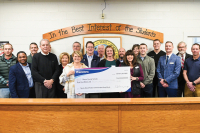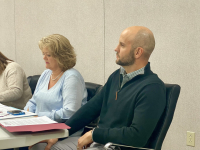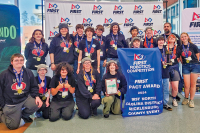Books helps us understand our own history
“We need to know what kind of firm ground other men, belonging to generations before us, have found to stand on. In spite of changing conditions of life they were not very different from ourselves, their thoughts were the grandfathers of our thoughts, they managed to meet situations as difficult as those we have to face, to meet them sometimes lightheartedly, and in some measure to make their hopes prevail. We need to know how they did it.”
— John Dos Passos, cited in the epigraph for Wilfred M. McClay’s Land Of Hope
WNC was once home to marble mines
(Editor’s note: This article first appeared in The Smoky Mountain News in June 2004)
The destiny of a given region is largely determined by its geology, topography, flora, and climate. That’s certainly been the instance here in the southern mountains, where logging and mining have been supplanted as the major industries by recreation and ecotourism. A prime example of this transition exists in the southwestern tip of North Carolina.
The story behind the man: First-ever Horace Kephart biography explores a complex man and momentous life
Horace Kephart has been dead for 88 years, but his name and his story still pull an undercurrent through Western North Carolina.
Kephart is acclaimed as the father of the Great Smoky Mountains National Park, an outdoorsman gifted with an adventurous soul, and the author of such staples of regional literature as Our Southern Highlanders and Camping and Woodcraft. He’s derided, too, as a man with a severe drinking problem, a shirker of family responsibility and an outsider who profited off of sometimes less-than-flattering depictions of the locals.
Pain was the norm with old-time dentistry
Editor’s note: This article first appeared in The Smoky Mountain News on May 14, 2003.
Old-time dentistry as practiced here in the Smokies region wasn’t pretty. All of the descriptions I have found make it seem just about barbaric, but, then again, when you’ve got tooth problems you’ll resort to just about any remedy. John Parris, in a chapter titled “Tooth-jumpin’ With A Hammer” in his book These Storied Mountains (1972), provides these insights in regard to a great-uncle who practiced homespun dentistry.
Deserving books that may pique your interest
On the red wooden chair near my desk, 14 inches high, is a mound of books waiting for review. Three or four of them have taken up residence on that red chair for months, clamoring for attention. Others are more newly arrived.
Reflections on Haywood NAACP pilgrimage
By Katherine Bartel • Secretary, Haywood County NAACP
“My little brother Isaiah is, as you would call it, ‘a boy of color,’” said 11-year-old Alicia Matthews. “He is probably one of the smartest 6 year olds you’ll ever meet. One time we were playing in his room and all of a sudden he asks me a question just randomly out of the blue, ‘Alicia? Why do I have brown skin?’ At first, I didn’t know what to say to him because he is so young and he barely knew who he was. I said, ‘Because that’s who you are. So don’t try to be anyone else.’ He responded to me with a simple ‘OK’ because he is still very young and that’s just how he responds to those kinds of statements.”
The tears of these poor men: Victims of Cowee Tunnel disaster deserve recognition
In a region as rich in local lore as this, it may seem like every story’s been told to death, including that of the infamous Cowee Tunnel disaster.
North Carolina, though, is also home to the old-world tradition of telling stories through song and has an ample supply of musicians like Balsam Range frontman Buddy Melton and his buddies, Haywood native Milan Miller and Piedmont bassist Mark W. Winchester, who on their 2010 album Songs From Jackson County relate the incident about as well as anyone else ever could.
Hiking through history: Little Cataloochee offers a window to the past
One hundred years ago, the parking area and campground just past the fields in Cataloochee Valley where elk often hang out was better known as Nellie, a remote community in what is now the Great Smoky Mountains National Park.
As anybody who’s ever driven the steep and narrow access road from Jonathan Creek can imagine, it was hard to get in and hard to get out in the days when horsepower came mainly from actual horses. People didn’t have much, partly because of how difficult it was to transport outside goods up and over the ridge.
Telling Appalachia’s untold stories: Artistic effort aims to celebrate the female side of history
Just as millennia of rain and wind and heat and cold have carved the physical shape of the mountains for which Appalachia is named, so have years of immigration and emigration and peace and war carved the human culture that covers them. Through the centuries, each of millions of lives — men and women, Cherokee and white, black and Hispanic — has added its own chapter to the story.
Appalachian Women’s Museum anticipates pivotal year ahead
It’s shaping up to be a big year for the Appalachian Women’s Museum in Dillsboro. The nonprofit is preparing for its second annual Airing of the Quilts event, will get an artistically designed storytelling installation on its grounds if a grant Western Carolina University is working on goes through, and hopes to start regularly opening its doors to the public during Saturdays summer.





